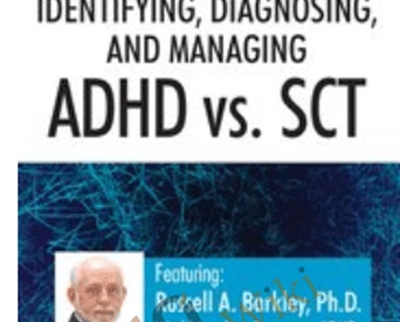The Two Attention Disorders: Identifying, Diagnosing, and Managing ADHD vs. SCT – Russell A. Barkley
 In this program Dr. Barkley provides detailed information on the specific nature of ADHD symptoms and the current DSM5 diagnostic criteria for ADHD.
In this program Dr. Barkley provides detailed information on the specific nature of ADHD symptoms and the current DSM5 diagnostic criteria for ADHD.
The Two Attention Disorders: Identifying, Diagnosing, and Managing ADHD vs. SCT by Russell A. Barkley,
Salepage link: At HERE. Archive:
In this program Dr. Barkley provides detailed information on the specific nature of ADHD symptoms and the current DSM5 diagnostic criteria for ADHD. He then reviews the various modifications necessary for updating the DSM criteria and making them more useful and rigorous with special populations (girls, adults, etc.). Dr. Barkley then addresses the issue of subtyping of ADHD along with the emerging conclusion that one form of the inattentive type may constitute a new disorder known in research as sluggish cognitive tempo or sometimes called ADD by clinicians.
- Characterize the specific nature of the inhibition and attention deficits in ADHD
- Apply DSM-5 criteria effectively to accurately diagnose ADHD and develop successful treatment interventions
- Utilize modifications to DSM-5 criteria to improve diagnostic rigor and identification of Sluggish Cognitive Tempo (SCT)
- Discriminate effectively between ADHD and SCT
Advances in understanding the symptoms of ADHD
Dimensions of deficits – hyperactivity-impulsivity and inattention
Subtypes of attention impairment
DSM-5 criteria for diagnosis of ADHD and varied presentations
- Inattentive, Hyperactive, Combined
Changes in criteria from DSM-IV to DSM-5
- Overlooked issues needing further explication
Sluggish Cognitive Tempo as distinct from ADHD
- History of presentation
Distinguishing SCT from Inattentive ADHD
- Prominent discriminating symptoms
- Use of Barkley SCT Rating Scale
- Demographic differences
- Cognitive presentation
- Current SCT research findings
- Comorbidity with ADHD and personality traits
- School and academic correlates
- Family and social distinctions
Impairment associated with SCT
- Relative comparison with ADHD impairments
Possible etiologies Basic nature of SCT – differentiating from normal styles of cognition Treatment interventions for SCT
- Medication research
- Psychosocial treatment considerations
Limitations of SCT conceptualization Summary and consideration of factors that potentially establish SCT as distinct from ADHD